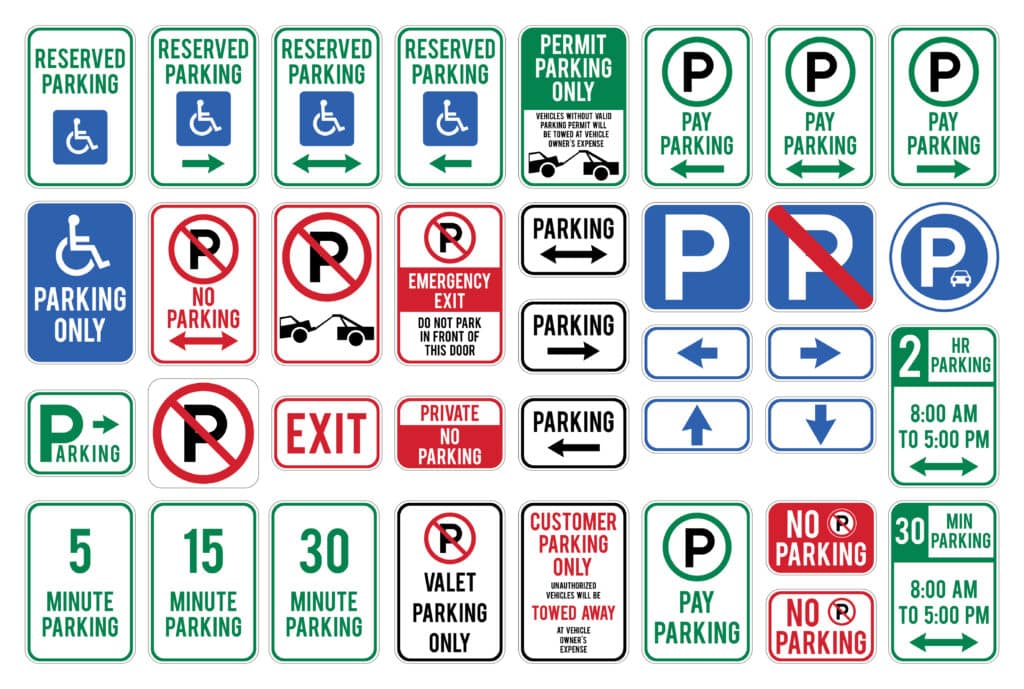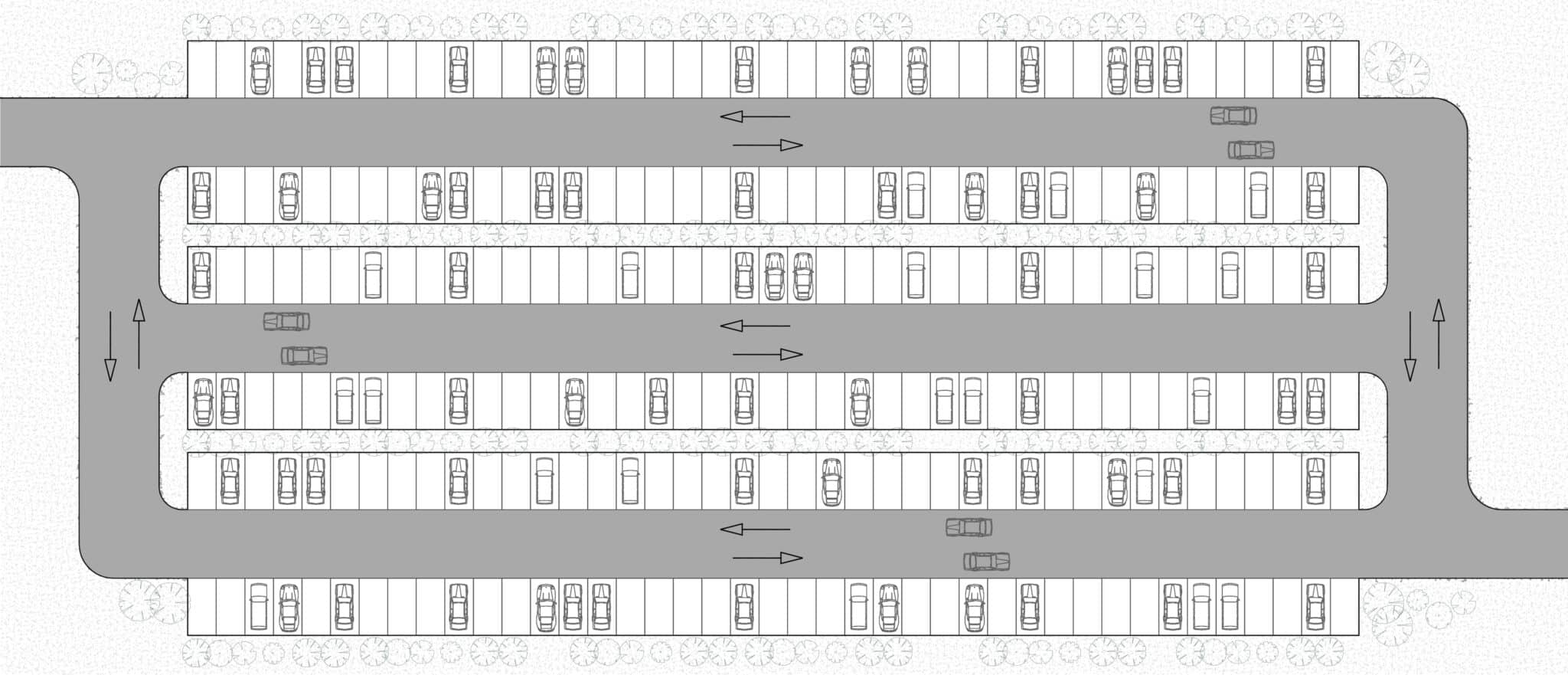Designing a parking lot might not seem like the most exciting task, but it plays a crucial role in ensuring smooth operations for your business. A well-executed parking lot design can significantly enhance how easily customers find a spot, navigate the area, and feel secure while doing so. In this post, we’ll explore practical tips for parking lot optimization to maximize every inch of your space. Whether it’s refining the layout, improving signage, or enhancing safety features, we’ve got you covered on how to create and optimize a parking lot design that is both efficient and hassle-free for everyone.
Evaluate Your Parking Lot Design Layout
For business owners or property managers that oversee asphalt parking lots, it’s important to clearly understand your parking lot’s purpose, its capacity, and how it currently handles the parking demand. Then, depending on the parking lot’s primary purpose, you will want to optimize your parking lot design to ensure that it can accommodate the needs of those who frequently use it.
Many parking lots are not designed to accommodate the number of vehicles that use the space on a daily basis, which can lead to congestion and other problems. If you find that your parking lot is constantly full or congested, it may be time to re-evaluate the parking lot design and layout.
To help determine what improvements need to be made, be on the lookout for:
- Areas where vehicles are constantly driving or parking in the wrong direction
- Parking spots that are too small or too close together
- Lack of accessible parking or other designated parking spots
- One-way entrances/exits that are not clearly marked
These are just a few things you should look for when evaluating your parking lot design. Once you have identified areas that need improvement, you can begin to map out your parking lot design.
Big Picture Parking Lot Design Factors
As you begin to map out your parking lot, there are a few key questions and considerations you will want to keep in mind for your parking facility.
Questions to consider:
- What type of parking lot design will best accommodate the needs of your customers or employees?
- Are there any specific regulations or code requirements that need to be met?
- How can you ensure your parking lot is accessible for all users?
- What type of parking lot surface will best meet the needs of your parking lot?
- How does the setting constrain your layout decisions?
Some of the considerations you will want to keep in mind include:
- The location of the parking lot in relation to your business or home.
- The type of vehicles that will be using the parking lot regularly.
- How many parking spaces you will need to accommodate all vehicles.
- The size and shape of your parking lot.
- Topography (hills, slopes, etc.)
- Vegetation (trees, bushes, etc.)
- Drainage
- Lighting
- Signage
Once you have considered all the questions and factors above, you can begin designing your parking lot layout. This is where the planning really comes together, and your decisions start to shape how the space will function on a daily basis. There are several layout options to choose from, each with its own pros and cons depending on your specific needs and constraints. Whether you’re aiming for maximum space efficiency, easy navigation, or a balance between the two, carefully weighing these options will help you create a parking lot that not only meets the practical demands of your location but also enhances the overall experience for every user.
Traffic Flow
One of the most important parts of effective parking lot design is understanding how vehicles move through the space. Assessing traffic flow, and observing how drivers currently use the lot, can reveal issues that affect both safety and efficiency.
If drivers are parking in ways that block key traffic lanes or create bottlenecks, it not only disrupts the flow of vehicles but also increases the risk of accidents and frustration. Poor traffic flow can make navigation confusing and stressful, especially during busy times.
To assess and improve traffic flow in your parking lot, consider the following steps:
- Observe how people are currently parking: Look for patterns that cause issues, such as vehicles parking outside designated spots or too close to drive aisles.
- Identify main traffic zones: Determine where the highest volume of vehicle and pedestrian movement occurs.
- Spot problem areas: Take note of areas where parked cars block access or reduce visibility.
Once you’ve gathered this information, you can begin to make strategic updates to the layout, such as repositioning parking stalls, adjusting lane widths, or adding directional signage. These changes can significantly reduce congestion and make the lot safer and easier to navigate for everyone.
Improving Traffic Flow
Once you have assessed traffic flow, you can begin creating a plan for it. Some of the parking lot optimizations and changes you may want to make include:
- Changing the size or shape of parking spaces
- Making entrances and exits more visible
- Adding or removing parking rows
- Changing the parking lot layout
- Adding more parking spaces
- Creating one-way aisles
- Adding signage
In addition, you will want to ensure that your parking lot design allows for easy pedestrian access to all businesses or buildings on the property. If people walk a long distance to get to their destination, this can cause frustration and lead to parking problems.
By making changes to the parking lot design, you can improve traffic flow, reduce congestion, and ensure your parking lot is accessible for all.
Parking Space Configuration
One of the most critical aspects of parking lot design is the configuration of parking spaces. The parking space configuration will be determined by the size and shape of your parking lot and the type of vehicles that will be using the parking lot regularly.

The three most common parking space configurations are perpendicular, angle, and parallel.
- Perpendicular parking spaces are the most common type of parking space configuration and are typically found in parking garages and lots with multiple rows of parking.
- Angle parking spaces are typically found in parking lots with fewer than 30 parking spaces.
- Parallel parking spaces are typically found in residential areas and streets with two-way traffic.
Deciding which parking space configuration is right for your parking lot will depend on several factors, including the size and shape of your parking lot, the type of vehicles that will be using the parking lot, and the amount of traffic in the area.
Parking Space Dimensions
The dimensions of parking spaces will be determined by the type of vehicles using the parking lot. The three most common types of parking spaces are standard, compact, and accessible.
- Standard parking spaces are typically 9 feet wide and 18 feet long and can accommodate most sedans, SUVs, and trucks.
- Compact parking spaces are typically smaller than standard parking spaces and are usually used for smaller vehicles, such as motorcycles, scooters, and bicycles. The dimensions of compact parking spaces are typically 16 feet long and 8 feet wide.
- Accessible parking spaces are designated for people with disabilities and are typically wider than standard parking spaces. Accessible parking spaces are at a minimum of 8 feet wide, van accessible spaces are eleven 11 wide, and access aisles for either type of space are five 5 feet wide.
While compact spaces aren’t necessary, accessible parking spaces are required by law in most states. Therefore, it’s important to consider the needs of all drivers when designing your parking lot.
Read more: ADA Guidelines for Parking Lots
Parking Space Angles
In addition to the dimensions of parking spaces, you will also want to consider the angles of parking spaces. The angled parking spaces will be determined by the type of parking space configuration you choose.
There are four basic parking angles used for the rows of parking area stalls:
- Thirty degree (30°): This parking angle is typically for parallel parking spaces.
- Forty-five degree (45°): This parking angle is generally for angle parking spaces.
- Sixty degree (60°): This is the most common parking angle and is typically used for perpendicular parking spaces.
- Ninety degree (90°): This parking angle is typical for parking garages and lots with multiple rows of parking.
The angle of parking spaces can have a significant impact on the efficiency of your parking lot. For example, parking spaces closer together (e.g., 30° parking angles) will result in more parking spaces in a given area but may be more challenging to maneuver for some drivers. On the other hand, parking spaces farther apart (e.g., 90° parking angles) will result in fewer parking spaces in a given area but may be easier to maneuver for some drivers.
It’s important to strike a balance between the number of parking spaces and the ease of maneuverability when designing your parking lot. You will also want to consider the type of vehicles that will be using the parking lot when determining the angle of parking spaces. For example, if you are expecting a lot of large trucks or buses, you will want to ensure that the parking spaces are wide enough and the aisleways are clear.
Parking Lot Signage

One of the most critical aspects of parking lot design is implementing new signage and markings to help guide drivers. If your parking lot is not clearly marked, this can lead to confusion and parking problems.
To help guide drivers, you will want to:
- Add signage to indicate the entrance and exit of the parking lot
- Add signage to indicate the direction of traffic flow
- Add signage to indicate handicap parking spots
- Add markings on the pavement to indicate parking spots
- Add markings on the pavement to indicate fire lanes
Adding signage and markings can help drivers navigate the parking lot easily and avoid unnecessary collisions or accidents.
Loading Zones
Another vital aspect of parking lot design and overall traffic flow is creating designated spots for loading and unloading. For example, if you have a business that relies on deliveries, it is important to have designated parking spots for delivery trucks. This will ensure that deliveries can be made promptly and that parking spaces are not blocked for other customers.
In addition, you will want to create designated parking spots for people picking up or dropping off passengers. This can help reduce congestion and make it easier for people to find parking.
To do this, you will want to:
Identify areas where people are picking up and dropping off passengers
- Determine how many parking spots are needed
- Designate parking spots for loading and unloading only
- Add signage to indicate the designated parking spots
Having a safe space for people to load and unload can help to reduce congestion, create safe traffic flow, and make it easier for people to find parking spots.
Pedestrian Safety and Convenience
Another key aspect of parking lot design is pedestrian safety and convenience. If your parking lot is not designed with pedestrians in mind, this can lead to accidents and injuries.
To help create a safe environment for pedestrians, you will want to:
- Create designated walkways
- Add signage to indicate the designated walkways
- Install crosswalks or pedestrian crossing signs
- Add lighting to the parking lot
- Install speed bumps
Taking these steps can help create a safe environment for pedestrians and reduce the risk of accidents.
Visual Parking Lot Barriers
If you have a parking lot adjacent to a busy street, you may want to consider adding landscaping or fencing around the parking lot’s perimeter. This can help create a visual barrier between the parking lot and the street, which can help to reduce noise and traffic.
Consider adding the following:
- Trees
- Shrubs
- Flowers
- Fencing
Landscaping can help to create a more inviting parking lot and reduce the amount of noise and traffic.
Parking Lot Security
Another critical aspect of parking lot design is security. If your parking lot is not well-lit or does not have security cameras, this can lead to crime.
To help deter crime, you will want to:
- Install lighting in the parking lot
- Install security cameras in the parking lot
- Add signage that indicates the presence of a security camera
- If you have a large commercial parking lot, hiring a security guard can help to deter crime.
These steps create a safe and secure parking lot for your customers and employees.
Prepare a Preliminary Parking Layout
Once you have considered all the above factors, you will want to prepare a preliminary parking layout. To do this:
- Identify the location of the parking lot
- Measure the size of your property (every available
- Determine the number of parking spots needed
- Plan for accessible parking spots
- Outline where your entrance and exits will be
- Follow the above outline for the rest of your parking lot layout design.
Once you have a preliminary parking layout, you can begin to design your final parking lot layout.
Regularly Reassess Your Parking Lot
Once you have implemented the above parking lot design tips, you will want to regularly evaluate the parking lot to ensure it is still functioning efficiently. This can help to identify any problems or areas that need improvement.
To do this, you will want to:
- Observe the parking lot during different times of day
- Talk to customers and employees about their experience
- Review parking lot security footage
Regularly evaluating the parking lot ensures it’s functioning efficiently and effectively.
Ultimately, there are a few key things to remember when designing a parking lot for maximum efficiency. With these parking lot design tips, you can create a parking lot that is safe, secure, and convenient for both pedestrians and drivers.
Asphalt Parking Lot Maintenance Solutions
If you are in need of a parking lot design overhaul, Superior Asphalt LC can help. We offer parking lot striping services that create an efficient parking lot design and help you construct a parking lot that is safe, efficient, and up to code. Contact us today for a consultation on how we can improve your parking lot design!




